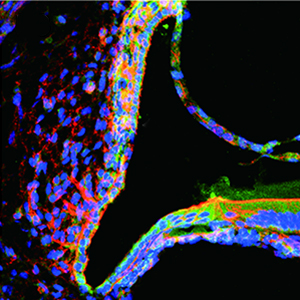Expression and localization of α2A-adrenergic receptor in the rat post-natal developing cochlea

All claims expressed in this article are solely those of the authors and do not necessarily represent those of their affiliated organizations, or those of the publisher, the editors and the reviewers. Any product that may be evaluated in this article or claim that may be made by its manufacturer is not guaranteed or endorsed by the publisher.
Accepted: 22 July 2023
Authors
Lots of adrenergic receptors (ARs) are widely present across the auditory pathways and are positioned to affect auditory and vestibular functions. However, noradrenergic regulation in the cochlea has not been well characterized. In this study, a rat model of noise-induced hearing loss was developed to investigate the expression of α2A-adrenergic receptor (AR) after acoustic trauma, then, we investigated the expression of α2A-AR in the developing rat cochlea using immunofluorescence, qRT-PCR, and Western blotting. We found that the expression of α2A-AR significantly increased in rats exposed to noise compared with controls. Immunofluorescence analysis demonstrated that α2A-AR is localized on hair cells (HCs), spiral ganglion neurons (SGNs), and the stria vascularis (SV) in the postnatal developing cochlea from post-natal day (P) 0 to P28. Furthermore, we observed α2A-AR mRNA reached a maximum level at P14 and P28 when compared with P0, while no significant differences in α2A-AR protein levels at the various stages when compared with P0. This study provides direct evidence for the expression of α2A-AR in HCs, SGNs, and the SV of the cochlea, indicating that norepinephrine might play a vital role in hearing function within the cochlea through α2A-AR.
Ethics Approval
All animal procedures were conducted in compliance with the National Research Council's Guide for the Care and Use of Laboratory Animals, and were approved by the Institutional Animal Care and Use Committee of the Air Force Medical University, Xi’an, Shannxi Province, China.Supporting Agencies
National Natural Science Foundation of China , National Key Research and Development Plan , Natural Science Foundation of Shaanxi , Shaanxi Provincial Clinical Medical Research Center , Research Promotion project from Xijing HospitalHow to Cite

This work is licensed under a Creative Commons Attribution-NonCommercial 4.0 International License.









